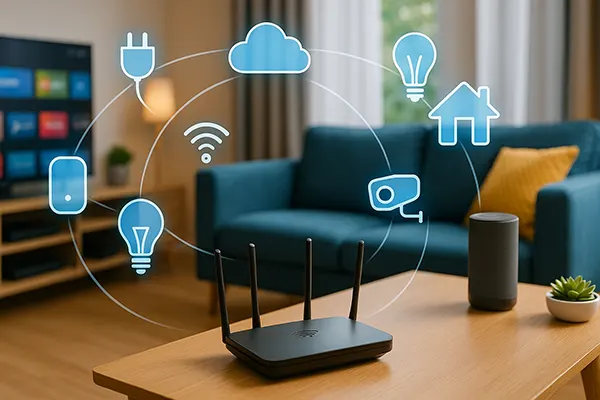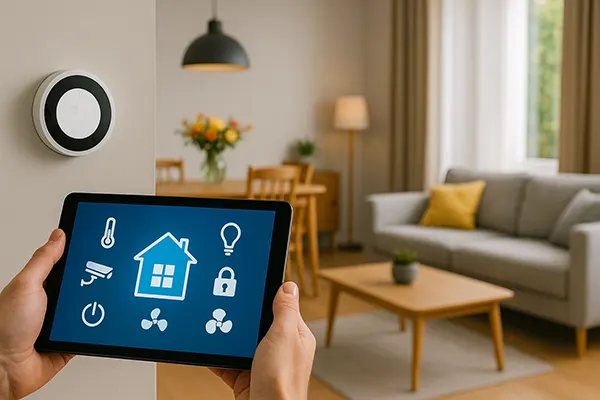Internet of Things in Everyday Life: Network Load and Traffic Optimisation

The Internet of Things (IoT) has transformed how households function, connecting everything from kitchen appliances to heating systems through intelligent automation. Yet, as the number of devices grows, so does the pressure on home networks. Understanding how to balance performance, reduce congestion, and optimise data traffic has become essential for maintaining stable and secure connections in 2025.
How IoT Devices Affect Home Networks
In modern homes, IoT devices communicate constantly, transmitting small data packets to cloud services, mobile apps, and other devices. Each smart plug, light bulb, or voice assistant contributes to cumulative network traffic. When dozens of such gadgets operate simultaneously, they can create a noticeable load on both bandwidth and router capacity.
Smart TVs and surveillance cameras are among the biggest contributors to traffic volume because they rely on continuous streaming and data transfer. As the number of these devices increases, traditional routers struggle to manage the simultaneous flow of data, resulting in slower speeds and potential connectivity drops.
Network interference is another major concern. Devices often share the same wireless frequency, especially the 2.4 GHz band, leading to congestion and packet loss. This makes network optimisation strategies crucial for maintaining reliability and consistent performance throughout the household.
Bandwidth Management and Prioritisation
Effective bandwidth allocation ensures that vital devices such as security systems and home offices receive network priority over less critical applications. Modern routers equipped with Quality of Service (QoS) settings can distribute traffic intelligently, minimising latency for essential services while balancing background IoT communication.
Users can further reduce strain by limiting cloud synchronisation intervals for less time-sensitive devices. For example, a smart thermostat doesn’t need to update data every second; configuring it to send updates periodically saves both bandwidth and energy.
Another valuable approach involves setting up separate networks for IoT devices. By isolating smart appliances from computers and personal gadgets, users reduce interference and improve both performance and cybersecurity.
Optimising Home Traffic Through Modern Technologies
Technological progress in Wi-Fi and networking hardware has brought efficient ways to handle IoT traffic. Wi-Fi 6 and Wi-Fi 6E, now widely available in 2025, significantly enhance throughput and latency management by using technologies like OFDMA and MU-MIMO to distribute data more effectively among multiple devices.
Mesh systems also play an essential role. By creating a network of interconnected nodes, they eliminate dead zones and ensure stable connectivity in large homes. This is particularly useful in properties with thick walls or multiple floors, where a single router might not deliver adequate coverage.
Cloud-based management tools have become another powerful resource for homeowners. They allow remote control over bandwidth distribution, device diagnostics, and firmware updates — ensuring networks remain both efficient and secure against evolving digital threats.
Security and Data Integrity Considerations
Optimising IoT traffic is not only about performance but also about protecting sensitive information. Each connected device represents a potential entry point for cyberattacks. Weak passwords, outdated firmware, or unencrypted connections can expose personal data to unauthorised access.
To mitigate risks, users should adopt encryption protocols such as WPA3, apply regular firmware updates, and disable unnecessary remote access features. Network segmentation also plays a key role in reducing exposure by limiting the communication range of potentially vulnerable devices.
Manufacturers increasingly integrate advanced security features into IoT products, such as automatic patching and zero-trust verification models, making home networks safer and more resilient against data breaches.

Smart Traffic Optimisation in the Future of IoT
As IoT ecosystems continue to expand, artificial intelligence will become indispensable in managing household networks. Intelligent routers already analyse traffic patterns to predict peak loads and automatically prioritise essential connections based on user habits and energy efficiency goals.
Edge computing is also gaining traction, allowing devices to process information locally rather than sending every piece of data to the cloud. This approach reduces latency, saves bandwidth, and strengthens privacy by keeping sensitive data within the home network.
Looking ahead, collaboration between telecom operators and IoT manufacturers is expected to produce more adaptive network standards capable of handling exponential device growth. This ensures that smart homes of the future remain fast, safe, and energy-efficient despite the ever-increasing digital demand.
Balancing Performance, Sustainability, and Convenience
Households in 2025 rely on stable connectivity for everything from entertainment to home security. Balancing high-performance networking with sustainable energy consumption is a growing priority. Smart traffic optimisation reduces not only bandwidth waste but also the power drawn by constantly active devices.
Energy-efficient protocols and intelligent scheduling help reduce the overall carbon footprint of connected homes. By transmitting data in bursts rather than continuously, IoT devices can maintain functionality while consuming less energy.
Ultimately, effective IoT management transforms the modern home into a well-coordinated digital environment — one where technology serves comfort, safety, and sustainability without overloading the network infrastructure.
